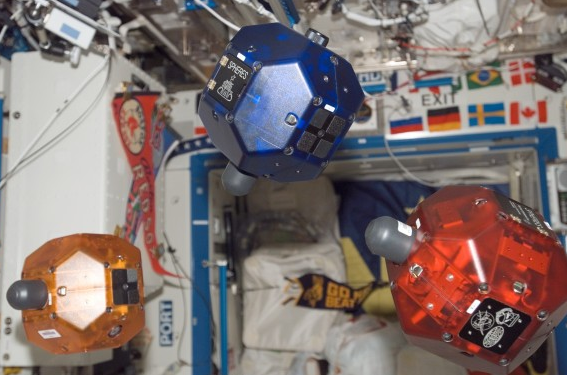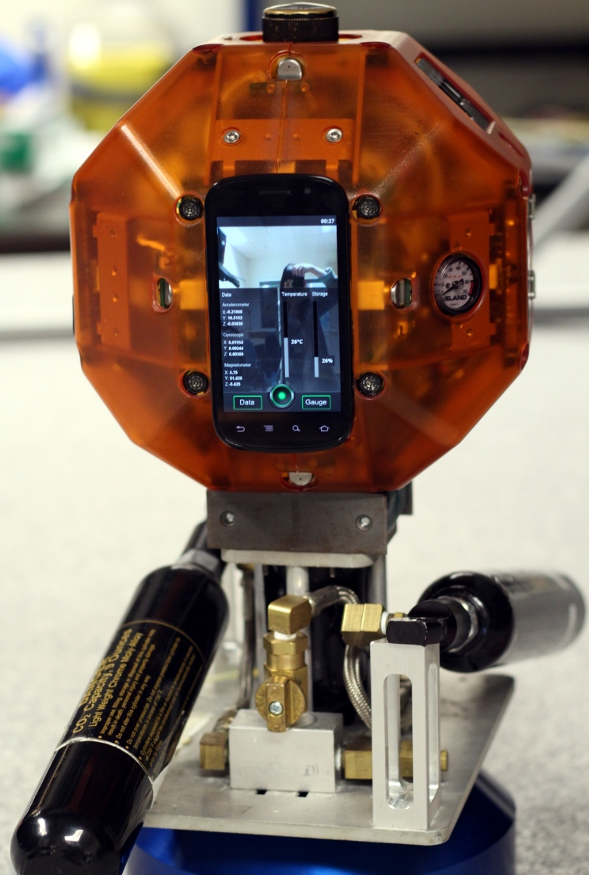Robots flying around in space seem more like fiction than reality, but recently NASA has been testing their free-flying robots called Smart SPHERES (Synchronized Position Hold, Engage, Reorient, Experimental Satellites) in the International Space Station (ISS).
Self-contained with power, propulsion, computing, and navigation equipment, the purpose of these volleyball-sized spherical robots, which have been on the Space Station since 2006, is to perform simple, routine tasks on the ISS, such as in-flight maintenance to keep the Space Station safe and habitable for humans. To receive more information from the inside of the ISS from Earth, NASA's Intelligent Robotics Group added an expansion port to each satellite for usage of additional sensors and appendages, such as cameras and wireless transfer systems.

The SPHERES have been on the Space Station since 2006 and were originally developed by the Massachusetts Institute of Technology through the Defense Advanced Research Projects Agency and NASA Small Business Innovation Research funding. Image via universetoday.com.
To transform the SPHERES into Smart SPHERES, project engineers at NASA equipped the free-flying satellites with an Android phone, the Nexus S, to function as the brains of the flying robots. By connecting a smartphone, the SPHERES immediately became more intelligent and automatically had a built-in camera to take pictures and videos, sensors to help with conducting inspections, a powerful computing unit for calculations, and a Wi-Fi connection that can be used to transfer data in real time to the ISS and Mission Control. The Nexus S was chosen because it's easy to take apart and simple to program.

The Nexus S functions as the brains of NASA's Smart SPHERES. Image via droiddog.com.
So far, the biggest accomplishment NASA has had with the Smart SPHERES is remotely controlling them — and getting a look at the inside of the ISS — from Earth.
“Last December, for the very first time, we were able to remotely control them from Mission Control in Houston,” Terry Fong, Director of NASA's Intelligent Robotic Group said of the Smart SPHERES. “For us, this was a big accomplishment, because for the first time ever, we were able to give people on the ground this mobile camera view inside of the Space Station. They've never had that to date, unless you count astronauts carrying cameras and flying around,” he said.
One of the biggest advantages of having a robot system that can be operated from Earth is that it allows Mission Control to have a better understanding of the Space Station's environment, and a greater awareness of what's going on aboard the station. This also allows the team to accomplish tasks remotely without requiring astronauts to be involved in every little thing that goes on inside of the Space Station.
“We're looking at free-flying robots to carry out a lot of work that we consider to be in-flight maintenance,” Fong said. “There's a lot of work involving just interior surveys. You need to make sure, for example, that there isn't excessive build of carbon dioxide and that you have the right levels of radiation and sounds and illumination.”
Right now that kind of work, which is time consuming and repetitive, as it's very important, is being done by astronauts carrying handheld measuring devices. According to Fong, “It's something that's really well-suited for robots to do automatically. Or maybe perhaps, monitor it from the ground.”
The ongoing experiment has demonstrated how the Smart SPHERES can serve as remotely operated assistants for astronauts in space. Though they're capable of conducting interior surveys and inspections by capturing images and video, NASA plans to test whether the robots can handle more challenging tasks.
It's very likely that in the future, small robots such as Smart SPHERES will be able to regularly perform routine maintenance tasks in space, giving astronauts more time to spend working on science experiments. Some day free-flying robots may also be used to inspect the exterior of the ISS and future space vehicles.
“As we look toward the future of space exploration, it's really my philosophy and I think that it's a philosophy shared by a lot of people in the robotics community within NASA, that humans and robots will be out there exploring together,” Fong said.

Want to go behind the scenes with NASA? Littelfuse has created an Exploration & Discovery Experience for the engineering community as part of its 2013 Speed2Design program. Winning design engineers will get the opportunity to spend time with NASA engineers at two NASA facilities and learn about the latest in space technology. For more information and to enter, visit speed2design.com.
Advertisement
Learn more about Electronic Products MagazineNasa





